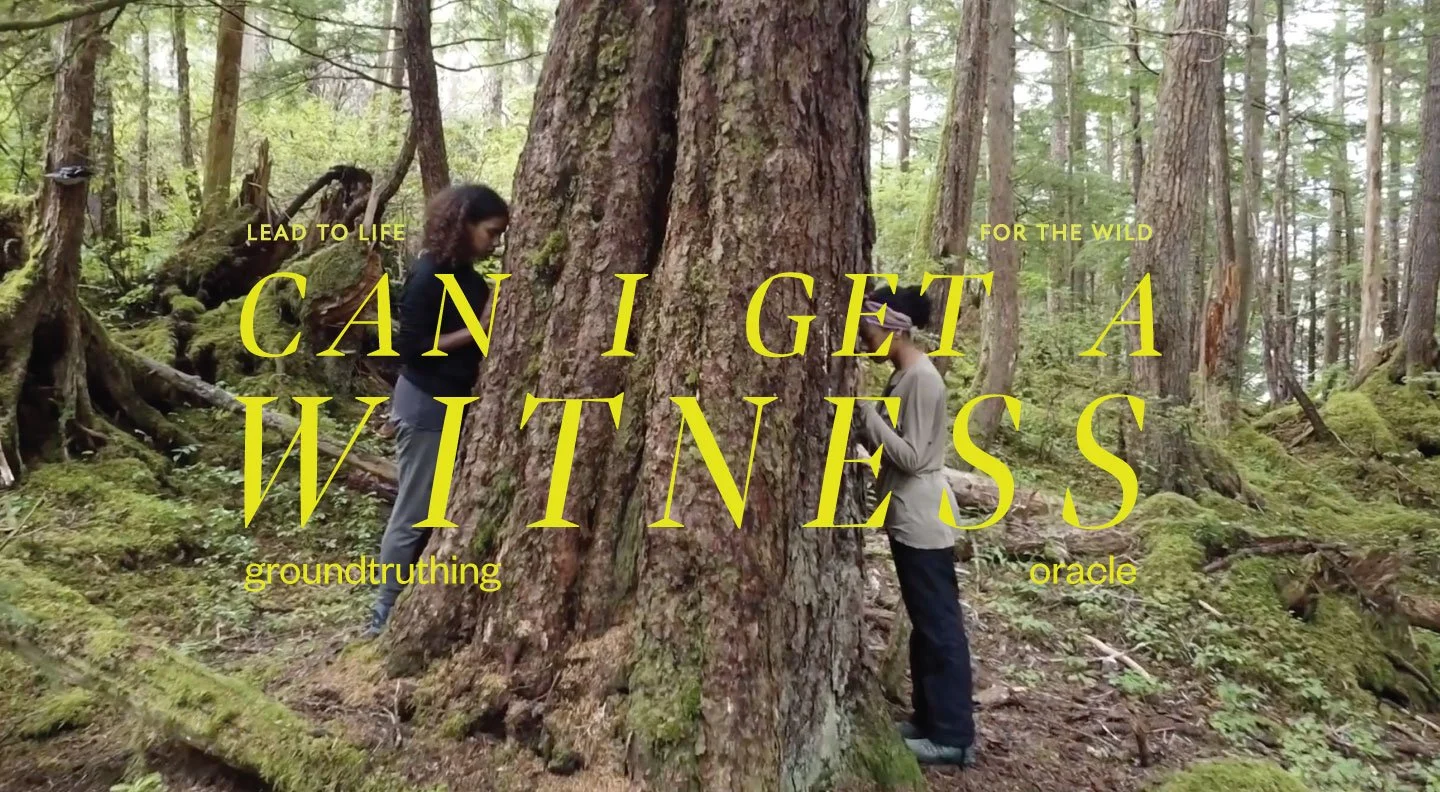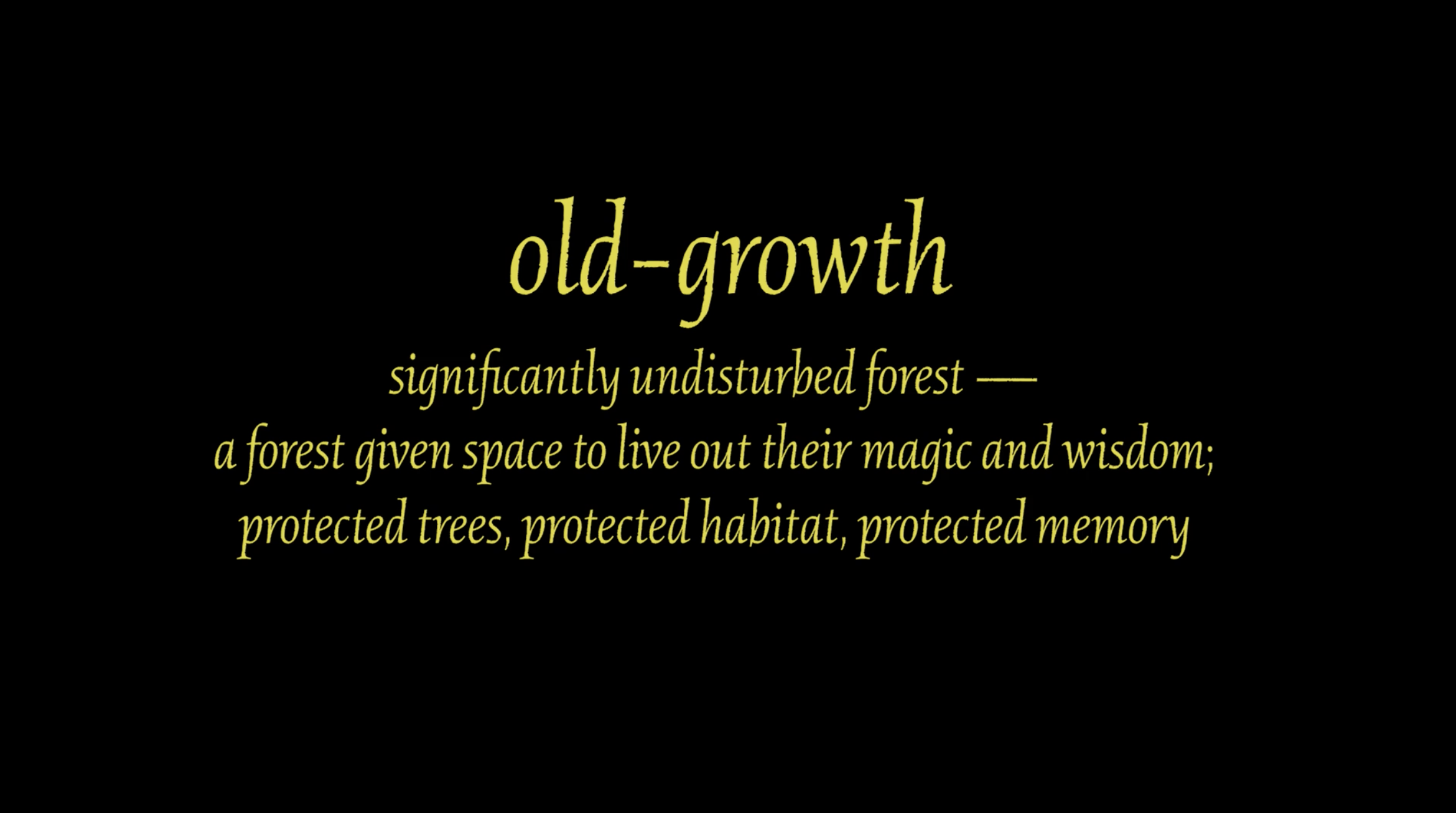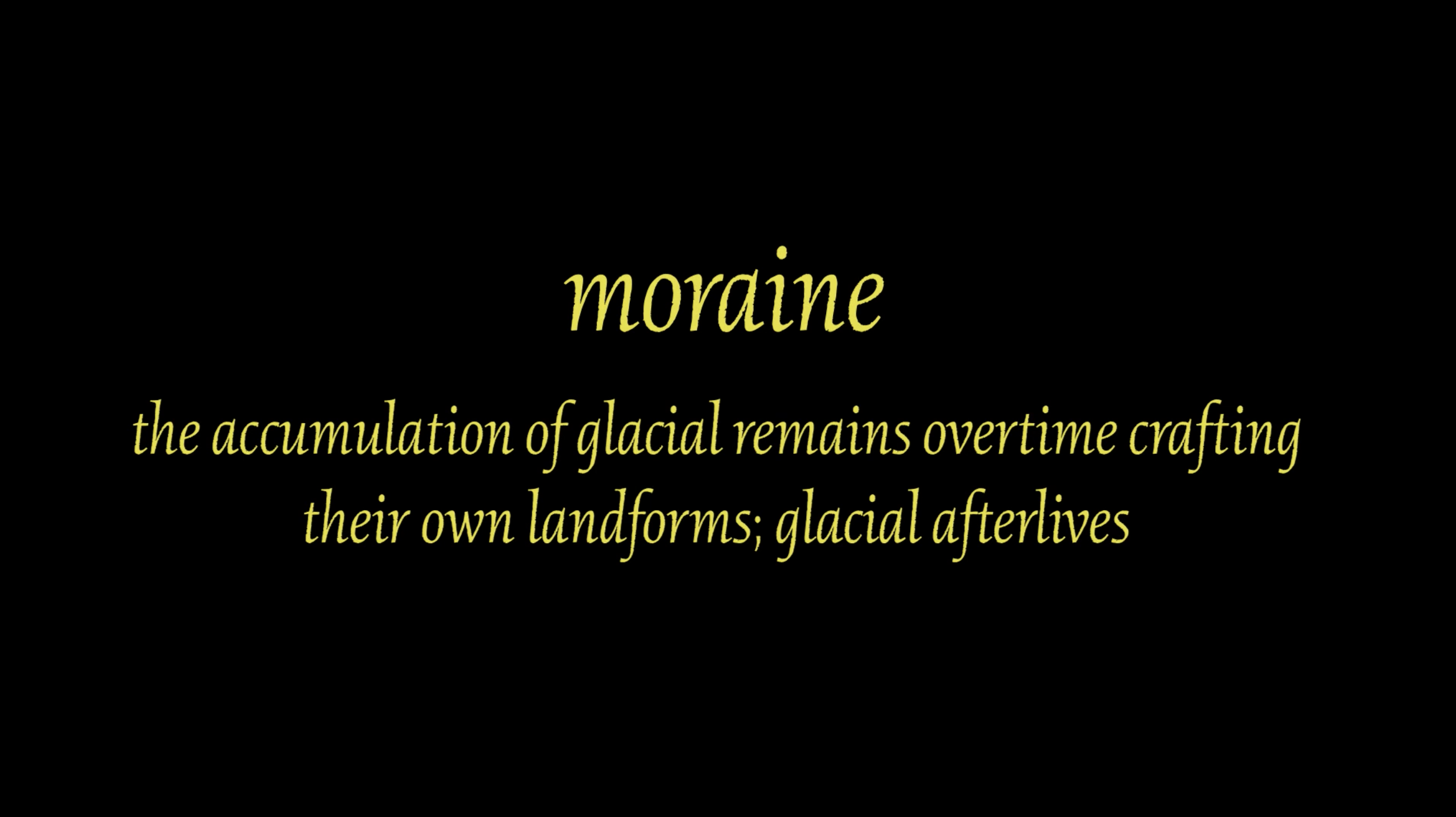Gratitude
To Tlingit, Haida, Tshimshian peoples and lands for your commitment to the protection of these lands, waters and beings. For your prayers, attention and care. For the privilege to be encountered by the medicine of these lands. May this work serve as a prayer to protect Tlingit, Haida, Tshimshian peoples and lands.
We humbly continue listening for right relationship, accountability and regeneration to these lands and communities. May our practice serve this place and the prayer that Black liberation also requires Indigenous liberation.
On the prayer
Following black feminist scholar Tiffany King’s text, The Black Shoals: Offshore Formations of Black and Native Studies, CAN I GET A WITNESS is a transmedia project that traces two queer black latinx femmes (brontë velez & Stephanie Hewett) dancing before, and being danced by, the ecology, memory and stories of the Tongass National Forest and Glacier Bay in Southeast Alaska (unceded Tlingit, Haida, Tsimshian territories).
Scored by field recordings and music by cellist/acoustic ecologist Jiordi Rosales and interviews from the For The Wild podcast with Tiffany Lethabo King (interviewed by brontë velez), Wanda Kashudoha Culp and Kasyyahgei (matriarchal Tlingit elders and lifelong forest defenders of the Tongass & Glacier Bay interviewed by Ayana Young), the film and constellated media utilizes "dance as a grammar" (Tiffany King) to hold the complexity of it's narrative: tracing connections between melting ice in Alaska and the disappearing Caribbean, the separation of black and indigenous relations, and the critical suture that: black and indigenous femme survival requires the earth's health and "the land's refusal to be separated from flesh" (L.H. Stallings).
Produced by Lead to Life and For The Wild. Creative Direction by brontë velez. Executive Produced by Ayana Young. Videography by Molly Leebove & Jade Begay. Edited by Molly Leebove. Groundtruthing Oracle (Opening Segment) by jazmín calderón torres. Research by jazmín calderón torres. Music by Jiordi Rosales. Graphic Design by Erica Ekrem.
A note on the experience
We are inviting you into the seat of witness. Not to watch but to keep watch with. To behold and offer your attention to the Tongass National Forest, one of the last remaining intact ecosystems in the world, sheltering old-growth temperate rainforest, glaciers, fjords, and muskeg, ancestral territory of the Tlingit, Haida, Tshimishian peoples.
Ecologizing the admonition from Dr. King that “Injustice anywhere is a threat to justice everywhere” - we invite you to imagine and connect with the gravity that the Tongass National Forest is deeply connected to the lands you call home, even if elsewhere — This offering will take time.
Can I Get A Witness asks you to dance with them. They ask for your presence before rushing toward “action.” They ask you to couple defense with prayer. They ask you to engage the content slowly, to curb the attention economy, to rest your eyes, to get into your body, to embody the rhythm of glacier.
A note on the offering
A note that this work does not intend to speak on behalf of the Tongass, Southeast Alaska, or indigenous communities of Southeast Alaska at large or offer a comprehensive history of these lands. These images and reflections emerged from the production team’s invitation through Sitka Conservation Society to bear witness to and build relationship with the Tongass National Forest through artist residency and practice in an effort to mobilize our platforms to protect re-implementing the Roadless Rule, removed by the Trump Administration, in fall of 2020.
It is with deep reverence, humility and grace that we continue to live into the practice and inquiry of living in right relationship with occupied places and the privilege and invitation of mobility. We are conscious, and staying with the trouble, of what it means to travel to places that are not our ancestral homelands and we pray this offering reflects our efforts in solidarity across relations and bioregions. We pray it serves the livability of this place and those most connected to the land and vulnerable within it.
Featuring
Wanda Kashudoha
-
Wanda Kashudoha Culp is an Indigenous Tlingit activist and advocate, born and raised in Juneau and Hoonah, Alaska. A self-described professional paper-pusher and artist by trade, Wanda is also a hunter, fisherwoman, and gatherer of wild foods. She is the mother of three children, and is recognized as a storyteller, cultural interpreter, playwright, and co-producer of the film Walking in Two Worlds. A long-time forest defender, Wanda currently serves as the Women’s Earth and Climate Action Network Coordinator for the Tongass National Forest.
Tiffany Lethabo King
-
Tiffany Lethabo King (her/they) is a descendant of African people enslaved in the US South. She grew up in Lenapehoking and currently works/resides on Monacan Lands. King is an associate professor of Women, Gender, and Sexuality Studies at the University of Virginia. She is also a co-director of the Black and Indigenous Feminist Futures Institute (BIFFI) funded by the Mellon Foundation.
Tiffany is the author of The Black Shoals: Offshore Formations of Black and Native Studies (Duke University Press, 2019). As a scholar and teacher, she is committed to thinking about how centuries long relationships between Black and Indigenous peoples have provided openings to alternative pasts, presents, and futures. Black and Indigenous liberation struggles informed by feminist and queer politics, as well as artistic production, and quotidian acts of survival and experimentation inspires her forthcoming scholarly and community building work.
Kasyyahgei
-
Ernestine “Kasyyahgei” Hanlon-Abel is a respected Tlingit knowledge keeper, a master spruce root and Chilkat weaver and spends each spring and summer gathering roots from the Tongass. She is a fierce protector of her community and village of Hoonah, and has spent decades fighting against industrial-scale logging and for the protection of the old-growth trees within the Tongass National Forest. In the 1980s, Kasyyahgei brought a lawsuit against the National Forest Service for logging in Hoonah and, since then, has continued to stand with unwavering integrity and courageously speak truth to power.
brontë velez
-
brontë’s work and rest is guided by the call that “black wellness is the antithesis to state violence” (Mark Anthony Johnson). as a black-latinx transdisciplinary artist, curator, trickster, educator, jibarx and wakeworker, their eco-social art praxis lives at the intersections of black feminist placemaking, abolitionist theologies, environmental regeneration, death doulaship, and the necessity of comedy.
they embody this commitment of attending to black health/imagination, commemorative justice (Free Egunfemi) and hospicing the shit that hurts black folks and the land through serving as creative director for Lead to Life design collective and ecological educator for ancestral arts skills and nature-connection school Weaving Earth. they are currently co-conjuring a mockumentary with esperanza spalding in collaboration with the San Francisco Symphony and practicing pastoral care as a co-steward of a land refuge in Kashia Pomo territory in northern California.
mostly, brontë is up to the sweet tender rhythm of quotidian black queer-lifemaking, ever-committed to humor & liberation, ever-marked by grief at the distance made between us and all of life .
Stephanie Hewett
-
Stephanie Hewett (she/they) is an interdisciplinary artist from the Bronx, New York (Lenapehoking territory) currently residing in Oakland, CA (Ohlone-Chochenyo territory). She is a graduate of Fiorello H. LaGuardia High School of Music & Art and the Performing Arts in New York City and has studied at the Laban Conservatoire of Music and Dance in London. She holds an MFA in Dance Studies and uses both music and movement to access pathways towards resistance and liberation rooted in spiritual, physical, and sonic defense. Hewett DJ's and produces electronic music under the moniker, Madre Guía. Her Afro-Caribbean roots guide her towards polyrhythmic potentialites of intergenerational healing.
Jiordi Rosales
-
Jiordi (hebrew variation of the river jordan, meaning to descend or flow down) encounters himself most deeply in places of confluence and immersive study — attentive to the forms of learning that most permit joy, humor, mystery, and contradiction. Traced by xicano lineages, by way of East L.A. to the Sonoran desert in Northern Mexico, and romani/jewish migrations, Jiordi is most granted breath by inquires into sonic imagination — as a luthier and instrument designer since childhood, he is theologically entangled in the ways that sound is created, how it travels, and the variance of forms through which it is perceived and given meaning.
Jiordi’s current season of work is in discipleship to that which evades the archive. He is the course manager for Bayo Akomolafe’s We Will Dance With Mountains, curator for The Emergence Network, wildland firefighter for Northern Sonoma County Fire District, and holds an M.A. in Ecology & Spirituality from the University of Wales. Currently living and attending to sanctuary at the headwaters of the gualala river, he and his kindred are focused on the rematriation of indigenous prescribed-fire practices / lifeways back to kashia territory and the north coast.























![TIFFANY LETHABO KING on The Black Shoals [with brontë velez], Part Two /316](https://images.squarespace-cdn.com/content/v1/5403e5dbe4b04db10d1d362b/1670886696027-B18TPEPB1F02GVOCNCRM/Tiffany-Lethabo-King_For-The-Wild_Episode2.jpg)
![TIFFANY LETHABO KING on The Black Shoals [with brontë velez], Part One /315](https://images.squarespace-cdn.com/content/v1/5403e5dbe4b04db10d1d362b/1670276370810-8C4398YL28P1N7EDZ8OG/Tiffany-Lethabo-King_For-The-Wild_Episode1.jpg)











